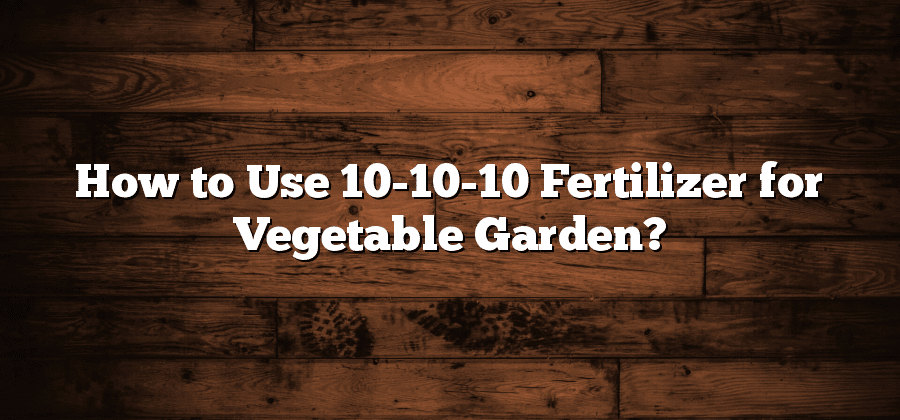Understanding the Composition of 10-10-10 Fertilizer
The composition of 10-10-10 fertilizer refers to its nutrient content, which consists of three main elements: nitrogen (N), phosphorus (P), and potassium (K). These numbers represent the percentage of each nutrient present in the fertilizer. In the case of 10-10-10 fertilizer, it contains 10% nitrogen, 10% phosphorus, and 10% potassium.
Nitrogen is essential for promoting leaf and stem growth, aiding in the production of chlorophyll, and enhancing overall plant vigor. Phosphorus plays a vital role in root development, flowering, and fruit production. It also contributes to the transfer of energy within the plant. Lastly, potassium helps regulate various physiological and biochemical processes in plants, including water uptake, nutrient transportation, and disease resistance.
Understanding the composition of 10-10-10 fertilizer is important as it allows gardeners to make informed decisions about its application. By knowing the specific nutrient content, gardeners can determine if this particular fertilizer is suitable for their plants’ needs. Additionally, the balanced ratio of nutrients ensures that plants receive a well-rounded supply of essential elements, promoting healthy growth and maximizing yields.
Selecting the Right Application Time for Your Vegetable Garden
One crucial aspect of maintaining a thriving vegetable garden is selecting the right application time for fertilizer. Timing plays a significant role in ensuring that your plants receive the necessary nutrients at the most optimal stage of growth. To determine the best application time, it is essential to consider the specific needs of the vegetables you are cultivating.
Different vegetables have varied nutrient requirements and growth patterns. For instance, leafy greens such as spinach and lettuce benefit from an early application of fertilizer, as this promotes vigorous foliage growth. On the other hand, root vegetables like carrots and radishes tend to require fertilizer later in their growth cycle, as this helps the roots develop and expand. By understanding the specific needs of each vegetable, you can select the appropriate application time and provide your garden with the best chance of success.
Preparing the Soil for Fertilizer Application
When it comes to preparing the soil for fertilizer application in your vegetable garden, there are several important steps to follow. First and foremost, it is crucial to ensure that the soil is properly tilled and free from any large clumps or debris. This will create a smooth and even surface for the fertilizer to be spread evenly.
Next, it is essential to conduct a soil test to determine the nutrient levels and pH balance of the soil. This will help you identify any deficiencies or imbalances that need to be addressed with the appropriate type and amount of fertilizer. Additionally, understanding the specific nutritional needs of the vegetables you plan to grow is important in selecting the right fertilizer formula.
Furthermore, loosening the soil with a garden fork or tiller can be beneficial, as it helps improve the soil’s structure and allows for better nutrient absorption. Incorporating organic matter, such as compost or well-rotted manure, into the soil can also improve its fertility and overall health. By taking the time to properly prepare the soil for fertilizer application, you are setting the stage for a healthy and fruitful vegetable garden.
Measuring and Calculating the Correct Amount of Fertilizer
Measuring and calculating the correct amount of fertilizer is an essential step in ensuring optimal growth and health of your vegetable garden. Accurately determining the appropriate quantity of fertilizer to apply is crucial to avoid over- or under-fertilization, both of which can negatively affect plant growth and productivity.
To measure the correct amount of fertilizer, start by determining the size of your vegetable garden plot. Measure the length and width of the area and multiply these two values to calculate the total square footage. This information will serve as the basis for determining how much fertilizer is needed for your garden. The packaging of the fertilizer typically provides guidelines for application rates, specifying the amount to be used per square foot or per 100 square feet. By following these recommendations, you can ensure that you are using the correct amount of fertilizer for your specific garden size. Additionally, keeping track of the area covered by each bag of fertilizer will help you determine how much more you may need to purchase in the future.
• Measure the length and width of your vegetable garden plot
• Multiply the length and width to calculate the total square footage
• Refer to the packaging of the fertilizer for application rate guidelines
• Follow the recommendations for amount per square foot or per 100 square feet
• Keep track of how much area is covered by each bag of fertilizer
• Use this information to determine future fertilizer needs
Applying 10-10-10 Fertilizer to Your Vegetable Garden
Once you have selected the right 10-10-10 fertilizer for your vegetable garden, it is time to apply it properly. Applying fertilizer may seem straightforward, but there are a few key steps to follow for optimal results.
First, it is important to prepare the soil before applying the fertilizer. This involves removing any weeds or debris from the garden bed and loosening the soil with a garden fork or tiller. This will create a favorable environment for the fertilizer to penetrate and nourish the plants’ root systems. Additionally, testing the soil’s pH levels can help determine if any amendments are needed before applying the fertilizer. This ensures that your plants receive the right balance of nutrients for healthy growth.






